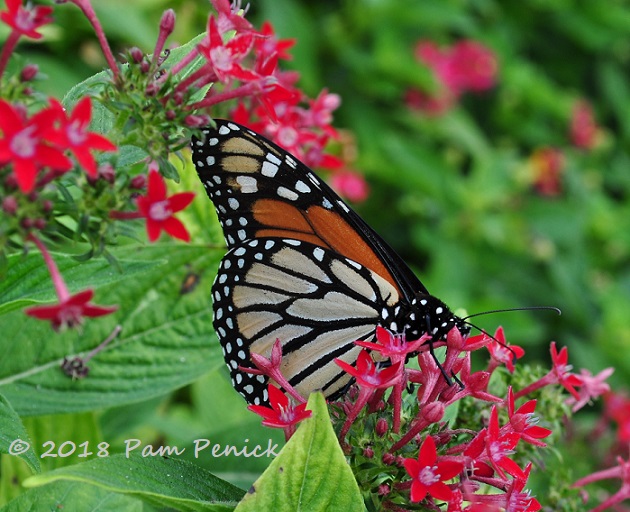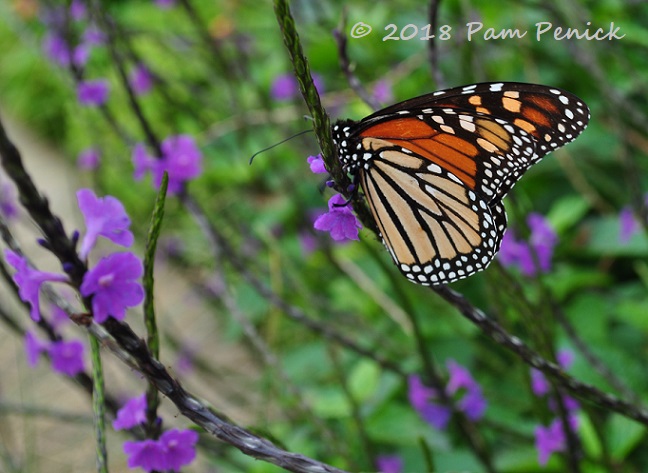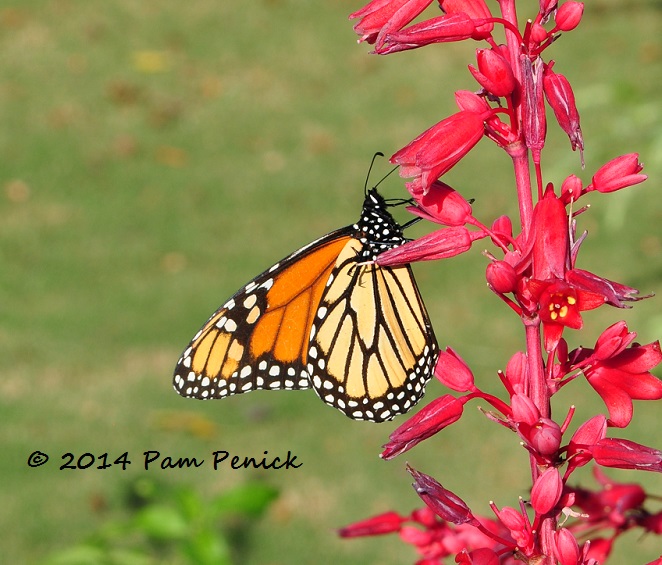Help the Monarch Migration – Cut Back Tropical Milkweed

Guest post by Sheryl Williams of Yard Fanatic
Monarchs are a beloved insect, and news of their declining numbers has caused alarm. Many homeowners have planted milkweed in an effort to supply larval food for the caterpillars. These good intentions mean that retail nurseries have rushed plant supplies to meet demand.
Unfortunately, the easiest milkweed to propagate for the retail nursery trade is the tropical variety, Asclepias curassavica. While it does serve as a host for monarch caterpillars, when planted outside of its native Mexico range it can disrupt the monarch migration. According to Monarch Joint Venture, in parts of the U.S. that do not have winter freezes, the year-round presence of tropical milkweed allows monarchs to breed throughout the winter. This is a problem because winter larvae are more likely than migratory monarchs to become infected with the debilitating parasite Ophryocystis elektroscirrha (OE). The infection spreads by spores from infected adults to the eggs and milkweed plant. In parts of the South, like Central Texas, it is possible for some newly hatched butterflies to reach the overwintering sites and spread the disease to the migratory population.

Therefore, Monarch Joint Venture recommends that tropical milkweed (Asclepias curassavica) be cut back in the winter and fall months in the southern U.S. and California, and homeowners should consider gradually replacing it with native milkweeds as they become available. Native milkweeds usually die back on their own and don’t pose a threat to the migration. If native varieties are not available, it’s okay to plant tropical milkweed; just know that it takes more careful maintenance and should be cut back October through February.

You can help by doing the following:
- If you have tropical milkweed in your garden, cut it back now (in early October) to about 6 inches in height and keep cutting it back through February as leaves re-sprout. It will die completely back if exposed to freezing temperatures and will likely sprout again in the spring.
- If possible, plant native milkweed. For the Austin area, the Lady Bird Johnson Wildflower Center recommends the following:
- Asclepias amplexicaulis (clasping milkweed)
- Asclepias arenaria (sand milkweed)
- Asclepias asperula (antelope horns)
- Asclepias tuberosa (butterflyweed)
- Asclepias viridiflora (green milkweed)
- Asclepias viridis (green antelope horn)
- It’s also important to have a nectar source for the traveling butterflies. Some examples of native bloomers are Gregg’s mistflower (Conoclinium greggii), shrubby boneset (Ageratina havanensis), and fall aster (Symphyotrichum oblongifolium).
The monarch winter migration to Mexico has begun, according to the Journey North database, and should pass through Central Texas any time now.
My thanks to Sheryl Williams for sharing her timely article. An earlier version of this post appeared first on her blog Yard Fanatic. –Pam
__________________________
Digging Deeper
Come learn about gardening and design at Garden Spark! I organize in-person talks by inspiring designers, landscape architects, authors, and gardeners a few times a year in Austin. These are limited-attendance events that sell out quickly, so join the Garden Spark email list to be notified in advance; simply click this link and ask to be added. Season 8 kicks off in fall 2024. Stay tuned for more info!
All material © 2025 by Pam Penick for Digging. Unauthorized reproduction prohibited.


Very curious as to why the recommendation to cut tropical milkweed before migration? It is an importasnt nectar source in our gardens. Monarchs also utilize it for eggs laying and caterpillars. What is the source of this information please. Our research does not support this recommendation. Thank You.
Hi Deena,
The research was done by Monarch Joint Venture. You can see the participants and other links here: https://monarchjointventure.org/images/uploads/documents/Oe_fact_sheet.pdf.
Nectar sources ARE important. The only issue with the tropical milkweed is that it encourages the Monarchs to lay eggs out of their normal season and breeding grounds. The discovery of the Ophryocystis elektroscirrha happened about 20 years ago, but it’s only been the past several years that it’s been traced to issues with Monarch health as they pass through southern states like Texas. We encourage people to plant a variety of native plants in their pollinator gardens to help avoid the issue while still supplying nectar to butterflies on the move.
If you are doing cage rearing at your garden, Monarch Watch has a great article about controlling OE through cleanliness and selection. https://monarchwatch.org/biology/control.htm.